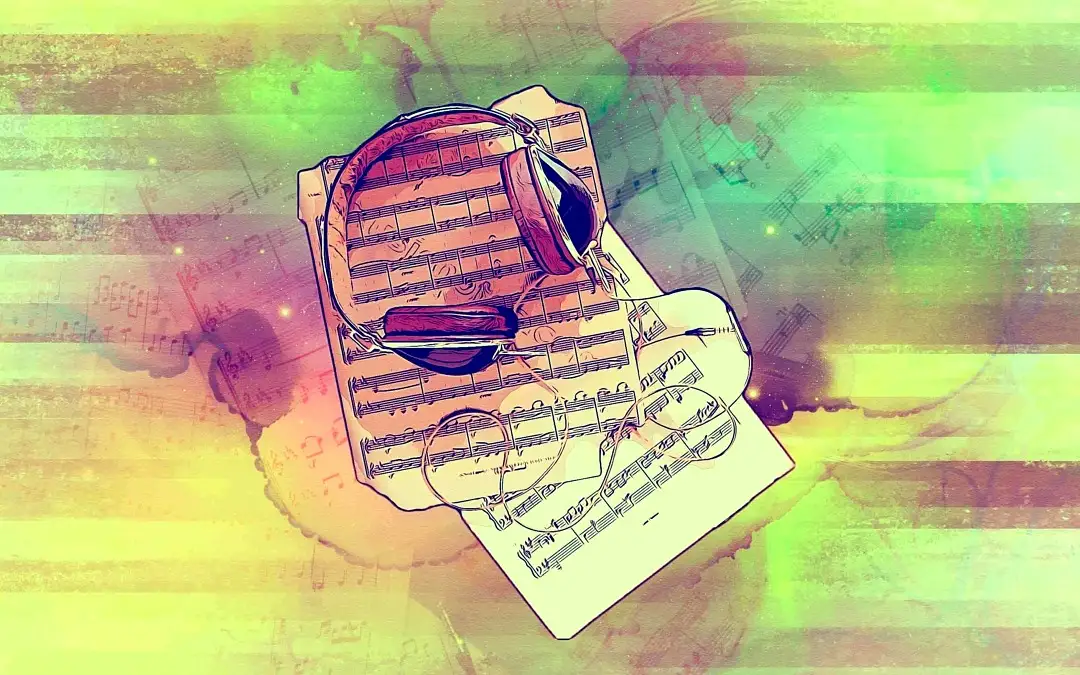Learning how to read sheet music is like learning how to speak a different language. Written music has been around for thousands of years, continuously developing to fit the bounds of what we're capable of as composers and creators.
In its most basic definition, music notation represents sound using a variety of symbols, which tell us about the pitch and duration properties of each note. Going even further than that, we have unique symbols that give us more information on the timbre and expression of certain notes.
Of course, you're probably here because, like the millions of other people learning how to read sheet music, you feel overwhelmed. We don't blame you.
The good thing is that we have all of the info you need to gain a deeper understanding of how to read sheet music. In this article, we'll go through all of the basics of reading sheet music, as well as a few advanced methods that you might find helpful as you progress.
Why Should I Learn How To Read Sheet Music?
Knowing how to read piano sheet music allows you to better understand the structures of different pieces of music and how they are put together, which, in turn, gives you a broader understanding of compositions.
The notes, clefs, symbols, lines, and spaces have been around for centuries, just like many spoken languages. Every symbol you see in a piece of piano sheet music represents a different rhythm , pitch, or tempo in a particular song.
There are many musicians out there that will tell you learning how to read piano sheet music isn't necessary to becoming a great player. While they are certainly right, not learning how to read piano sheet music can limit you in your abilities.
Some of the main reasons musicians look to learn how to read sheet music are:
- Learning how to read music can unlock your expressive side, whether you play piano, guitar, or any other instrument.
- Learning how to read music allows you to more easily play with bands and ensembles.
- Learning how to read music can help you sight read for other instruments, such as woodwinds, brass, or strings.
- Learning how to read music can help you communicate better with other musicians.
Regardless of if your main instrument is piano or not, knowing the basics of how to read music and knowing names of music notes can be helpful for navigating around the keyboard. You'd be surprised how well this kind of knowledge translates to other instruments.
The History Behind Learning To Read Musical Notation
It's important to note that we read music from left to right , just like you'd read a book. The reason we read it this way is that musical notation started out as a way to look at scale progression in a horizontal manner.
Up until the ninth century, when more than one voice was played or sang at once, it was typically in unison. However, just after the ninth century, polyphony became popular, and composers had to start concerning themselves with vertical harmony.
To satisfy the changing written music aesthetic, people built keyboard instruments, such as the piano, the harpsichord, and the organ.
Understanding Your Staff
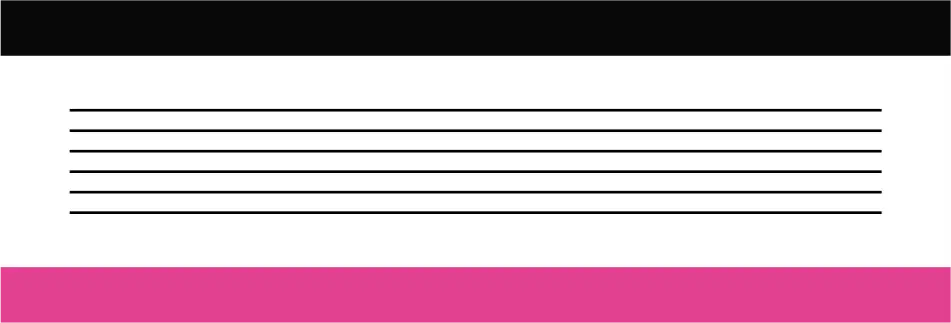
One of the most important elements of reading music you must tackle before you start actually learning music is understanding your staff .
A staff in music notation is a series of horizontal lines on which musical symbols sit. Each place in the staff is representative of a different note.
In modern western music, the staff is composed of lines and spaces (five lines and four spaces).
On the staff, you'll find different clefs, which tell you where the notes lie on the staff.
A Quick Musical Alphabet Pit Stop
So, at this point, you know that all the notes lie in the treble and bass clef sit on the lines and spaces. The question is,
Are those the only notes?
Absolutely not!
In fact, the piano is such a large instrument that it requires two staves for all the notes to fit. These staves are known as the treble clef and the bass clef. They include the notes:
A-B-C-D-E-F-G
The Two Clefs
Treble Clef
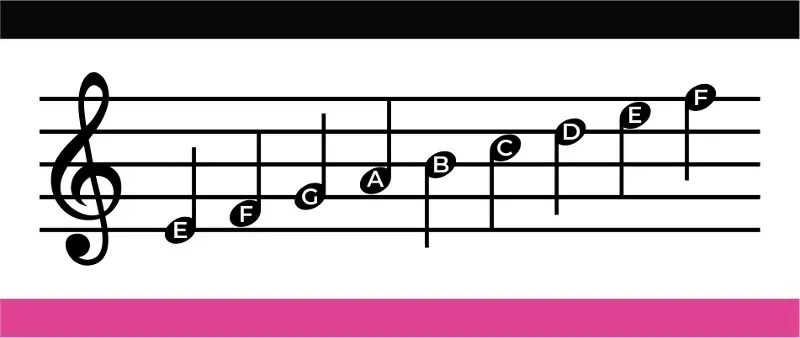
The treble clef, otherwise known as the G Clef, is one of the most recognizable symbols in music notation. It looks like a large, fancy cursive symbol and is placed at the far left of your staff. Similar to the legend on a map, your treble clef will tell you what range to play your instrument in.
The treble clef is for higher ranges, whether vocal or instrumental, hence the name "treble."
There are a few different qualities of the Treble Clef to remember.
For starters, the Treble Clef has a swirl that wraps around the line representing the note G , which is why people often refer to it as the G Clef.
There are notes that sit on the lines and spaces of the treble clef:
- The five lines, moving from the bottom to the top, represent notes E, G, B, D, and F . One mnemonic device you can use to memorize where these notes sit is E very G ood B oy D eserves F udge.
- The four spaces, moving from the bottom to the top, represent notes F, A, C, and E . One mnemonic device that you can use to memorize where these notes sit is that they spell out the word FACE .
Bass Clef
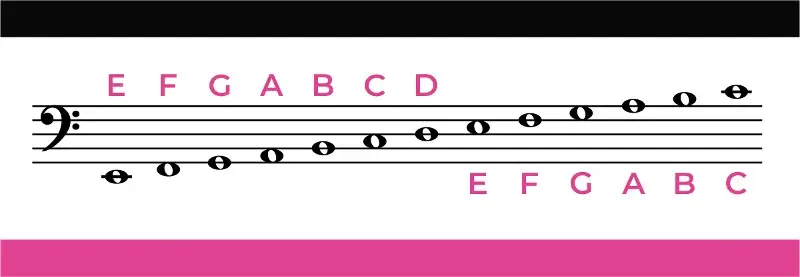
For lower voices and instruments, the bass clef is where it's at!
People often refer to this clef as the F Clef , thanks to the fact that the two small dots on the bass clef sit just above the line that represents the note F .
Just like the treble clef, here are notes that sit on the lines and spaces of the bass clef:
- The five lines, moving from the bottom to the top, represent notes G, B, D, F, and A . One mnemonic device you can use to memorize where these notes sit is G ood B oys D eserve F udge A lways .
- The four spaces, moving from the bottom to the top, represent notes A, C, E , and G . One mnemonic device that you can use to memorize where these notes sit is A ll C ows E at G rass.
Note that there are two other clefs in western music, including the alto clef and the tenor clef , though they aren't often used in common circumstances. For the sake of this article, we'll focus on the two most popular clefs.
Putting The Staves Together
When looking at piano sheet music, you'll often find that the two staves are linked together with the treble clef above the bass clef. It is also likely that you'll play the notes on the bass clef with your left hand and the treble clef notes with your right hand if you play the piano.
When these two staves are put together, we refer to them as the grand staff .
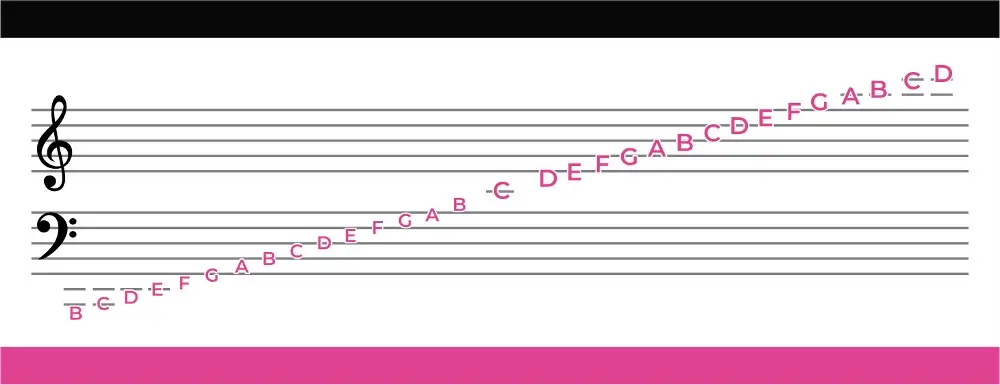
The Notes On The Clefs
Now that you have an understanding of the spaces and lines on these two clefs, we'll now talk about the notes that sit on them.
Notes are composed of three basic elements, including the head, the stem, and the flag(s).
The note head is shaped like an oval. It will either be open or closed. The open or closed look will provide information on the duration of the note.
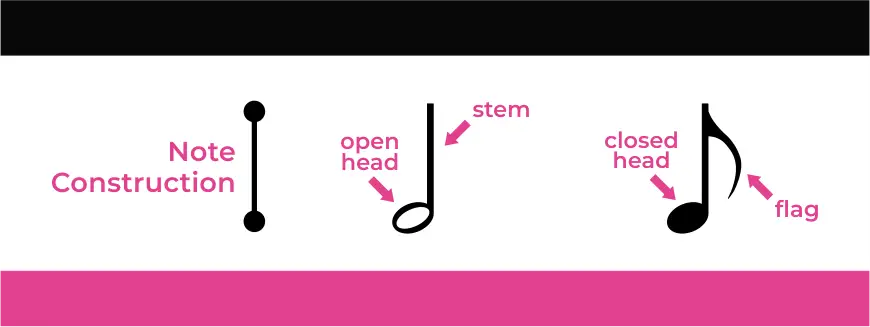
While a single note in sheet music is represented by a single note head, multiple heads stacked on top of each other signals the player to play multiple notes at the same time. This is how we write out chords.
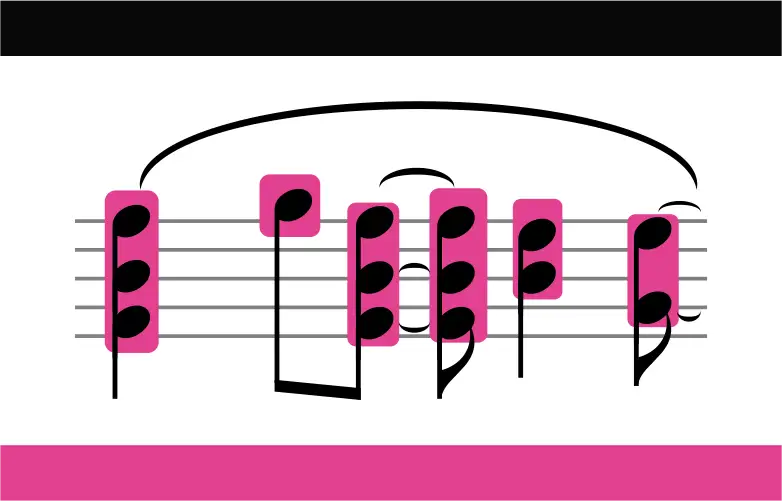
Next up, we have the stem , which is attached to the note head. Note that the direction of the stem (whether it is sticking up or down) will depend on how high or low the note is on the staff. Generally, if a note is above the staff's center line ( B on the treble clef or D on the bass clef), the stem will face down. However, if the note is below these lines, the stem will point up.
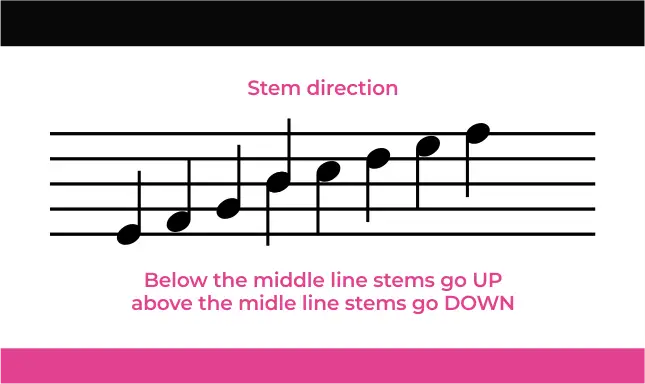
The direction of the stem does not impact the note in any way. It's purely there for aesthetic purposes, making sheet music easier to read.
The most important part of the stem is what sits at the top, which is the flag .
The flag is a stroke that curves to the right of the stem, regardless of whether the stem is facing down or up. The duration of the note depends on the number of flags on the stem. The more flags, the shorter the note value or duration of that note.
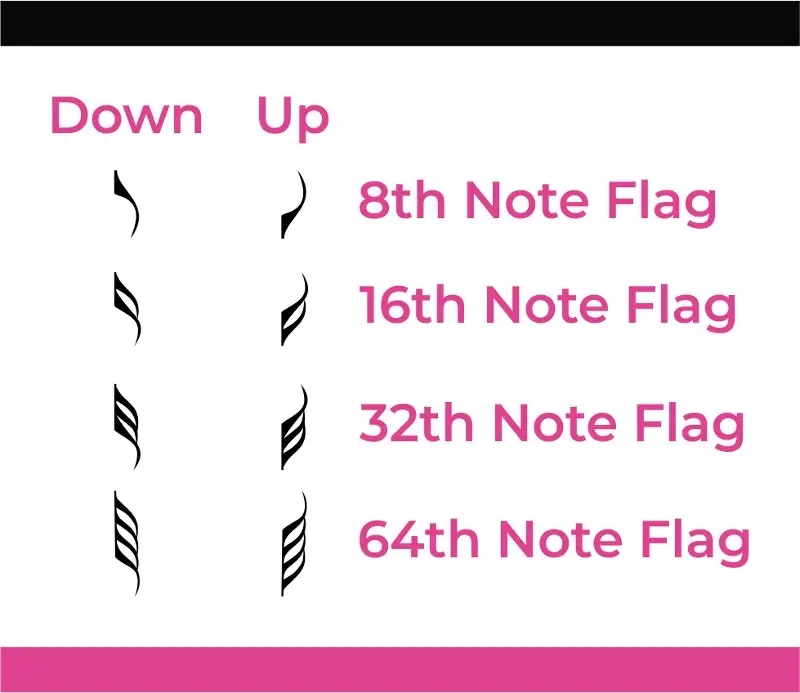
When you put all of these elements together, you get information on the time or note values for your given notes, measured in beats or divisions of beats.
Getting Your Timing Right
Measure Lines
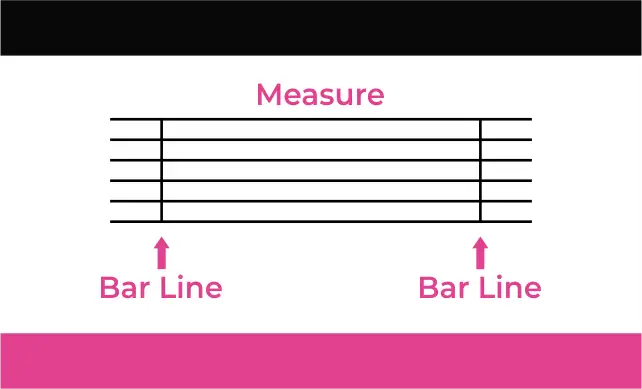
The very first thing to note when looking at a piece of sheet music is measure lines. Measure lines are the vertical lines that cross over the staff in regular intervals. Some people refer to the space between two measures as bars or measures .
Measure lines don't impact the sound of the music in any way. They are simply there to keep notes organized so performers can find their place. For example, if a conductor told you to go to the third measure, you could count three measure lines over from the beginning of the song to find your place.
Meter
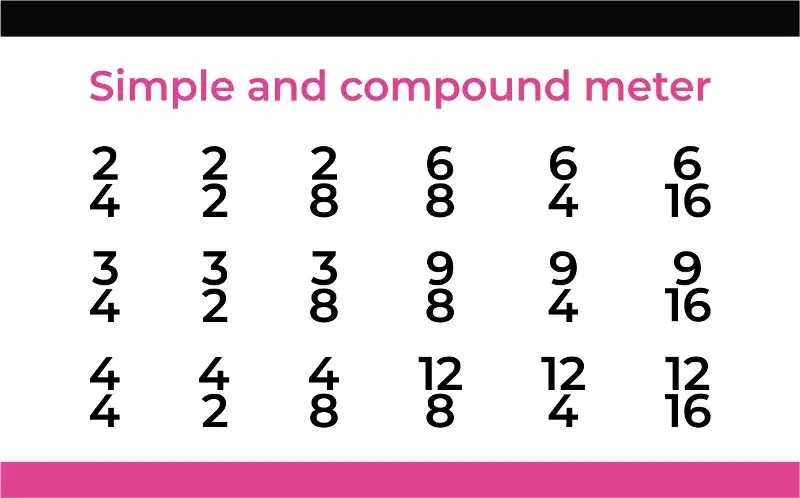
How many beats each measure holds is determined by the meter .
The most basic way we can describe a meter is as the beat or pulse of the piece of music. When you listen to your favorite pop song, we guarantee that you almost instinctively feel the beat or pulse. House music offers a foundational example of rhythm with the "boots and cats and boots and cats" beat.
When looking at a piece of sheet music, you'll see something that looks a lot like a fraction sitting next to the clef. If you hate math, don't be scared. I'll try and be quick here.
Like regular fractions, you have a numerator (top number) and a denominator (bottom number).
The numerator tells you how many beats are in a single measure .
The denominator tells you the note value that gets one beat .
When people start learning how to read sheet music, they typically start with the 4/4 meter, as it is the easiest to understand. In a 4/4 meter, otherwise referred to as 4/4 time or "common" time, you get four beats in every measure, and each of the notes is equal to a quarter note .
You can hear this meter in most popular music.
Now, if we were to change the numerator to 3 instead of 4 , we'd have three beats in every measure , and each of the notes is equal to a quarter note . This is the meter you'll find with most waltzes.
On the other hand, let's say we have 6/8 . In that case, we would have six notes in every measure , and each of the notes would be equal to an eighth note .
We'll get deeper into note values in a bit, though hopefully, this information will give you an understanding of meters.
Understanding Rhythm
Rhythm is one of the foundations of learning how to read sheet music, as it is one of the crucial parts of how music is supposed to feel.
Meters, as we talked about above, tell you how many beats are in a measure, while the rhythm is how we use those beats.
For the sake of understanding how rhythms work, we're going to think about quarter notes in 4/4 time. Let's imagine we have four quarter notes in a measure.
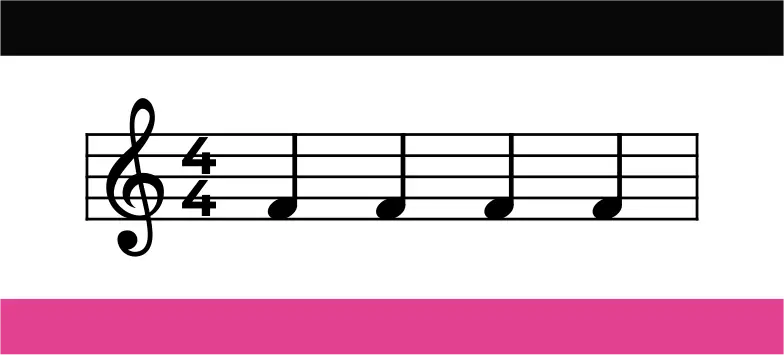
We can count this out as 1-2-3-4 . Try and tap your finger to those four counts in measures of 4.
Now, let's take what you're tapping and put it in half-speed. While counting 1-2-3-4 , only tap your fingers on the 1 and the 3 . Each of these taps is representative of a half note.
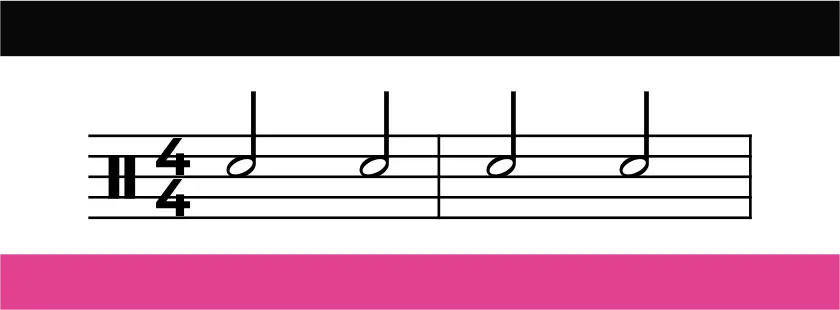
For fun, let's slow it down even more. While counting 1-2-3-4 , only tap your finger on the 1 and hold for the rest of the bar. This tap with a four-count duration is a whole note .

Now, let's go back to quarter notes, though instead of slowing down, let's speed it up to eighth notes. To double the speed of quarter notes, we will add a flag to the top of their stems to make eighth notes. These notes are half the value of quarter notes.
If we count 1-2-3-4 , we would tap 1 and 2 and 3 and 4 , so that we have eight taps for every four counts.
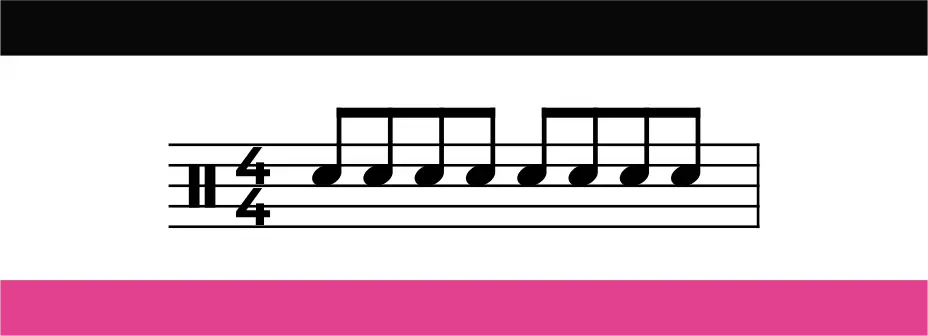
As you add more flags to the tops of the stems, it changes the value by double. A sixteenth note has two flags, a 32nd note has three flags, a 64th note has four flags, etc.
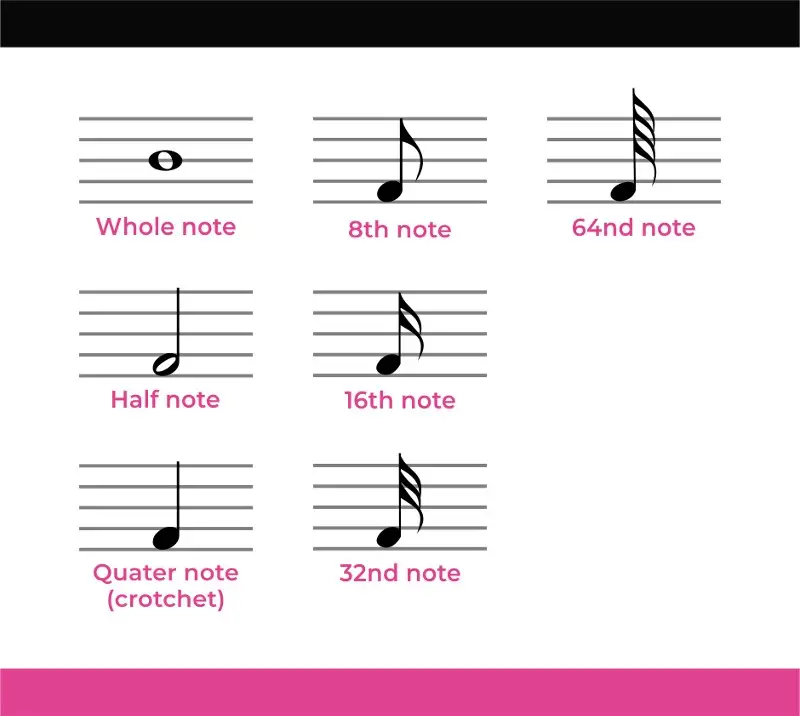
Linking Flags For Cleanliness
The beauty of music notation comes into play when things are cleaned up a bit. If you had tons of eighth notes flying around the page, it'd be a lot to take in and easy to start losing track of where you are.
Luckily, we can group notes with flags at the top using beams .
While the style of beaming can change based on the complexity of the music, we'll generally beam in groups of quarter notes or half notes.
The Value of Dots
Flags are made to divide the value of a note into two, while a dot elongates the value of a note. Most of the time, dots are placed on the right side of the head of the note.
A note with a dot is increased by half of the length of its value .
For example, let's say we have a dotted half note. The half note is equal to two beats, while the dot is equal to one-half of that half note, which is one beat. Overall, a dotted half note is worth three beats .
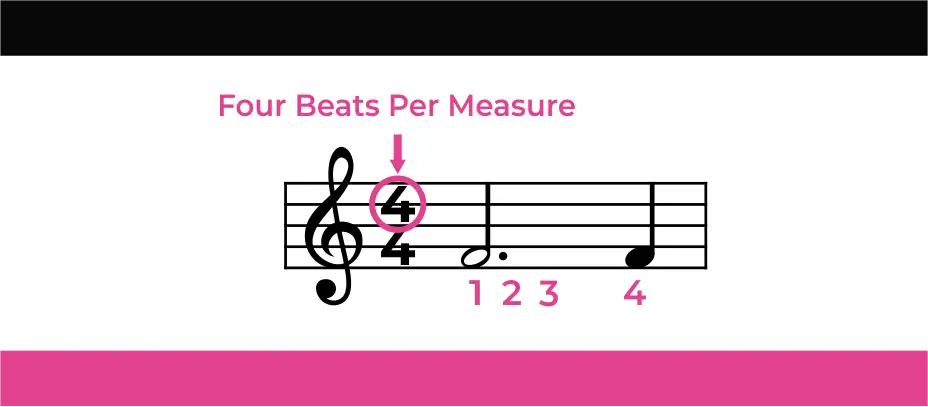
We can also use ties in place of dots depending on how we want to write out our music. Ties are used to extend notes by linking two notes together by the heads. The beauty of ties is that they are less abstract than dots, as dots are based on the value of the note they're attached to.
With a tie, if you have two half notes tied together, it'll equal a whole note or four beats. On the other hand, if you have a half note tied to a quarter note, it'll equal three beats.
One of the main reasons we use ties in sheet music is when the duration of the note won't fit within the given measure. We can tie that note to another note on the other side of the measure to extend the duration of the note.
Taking a Break With Rests
While we get sound and rhythm from notes, we get silence from rests, which are equally as important. The spaces where we're not playing add silence to music, which creates dynamics.
Similar to notes, rests have durations .
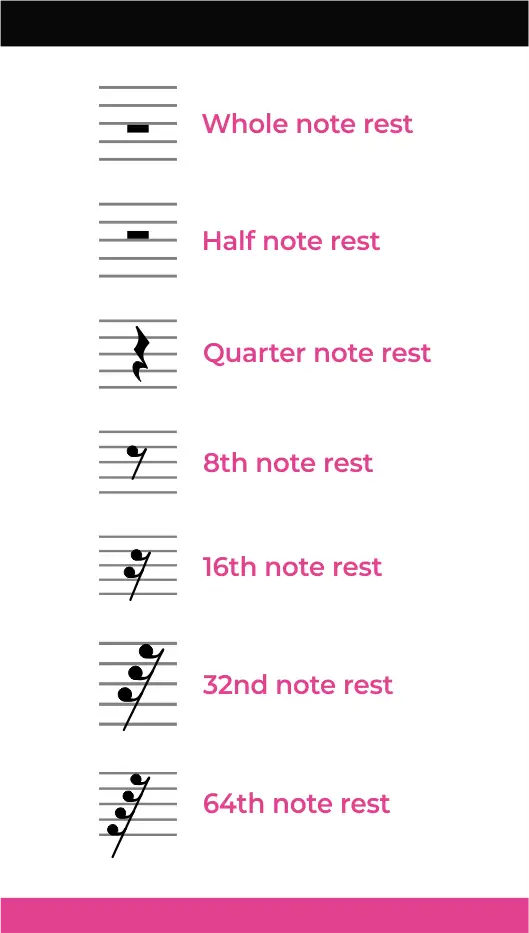
The first rest in this photo is a whole note rest , which looks a lot like a "hole" underneath the fourth line. This rest lasts for four beats.
The second rest is a half rest , which lasts for two beats. Many say this looks like a top hat sitting above the third line on the staff.
The third rest is a quarter note rest , which is a funky, squiggly line. This rest lasts for one beat or the duration of a quarter note.
The remaining rests are lines with flags leaning to the left.
- One flag is an eighth rest
- Two flags is a sixteenth rest
- Three flags is a 32nd rest
- Four flags is a 64th rest
Tempo Markings
You'll often find tempo markings sitting at the top portion of written music. If there are any tempo changes throughout the piece, the composer will often indicate them with another tempo change.
However, if they are not exact with the tempo by providing the BPM, they will sometimes use subjective musical terms , like andante, allegro, medium-fast, medium, slowly, gravely, etc.
There are even times when they'll indicate the rhythm with a feeling word, such as ballad or swing .
A Deeper Dive Into Tempo
In piano music, you'll mostly find Italian terms since they are conventional. When it comes to speeding up and slowing down in a piece of piano music, you'll often run across the terms Accelerando and Ritardando .
Accelerando is typically marked "accel," and means to gradually increase the speed or tempo.
Ritardando is typically marked "rit," and means to gradually decrease the speed or tempo.
There are also special markings, such as the fermata , which looks a lot like a small bird's eye.
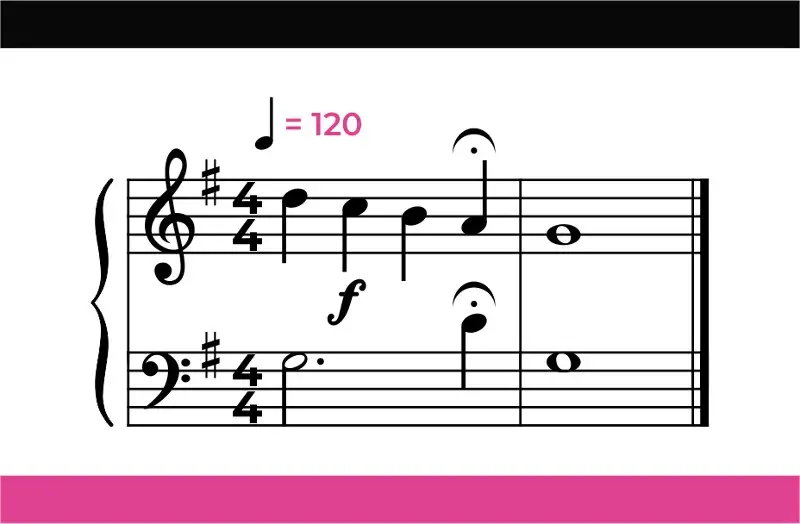
This symbol indicates that the player should take a short pause. The pause can be subjective, and it is usually up to the discretion of the conductor or the player(S).
Matching Your Rhythms With Melodies
Now that we have a grip on rhythm, let's move on and learn about how to create melodies . We can start with scales.
Understanding Scales
To get your footing, we'll start with the C major scale.
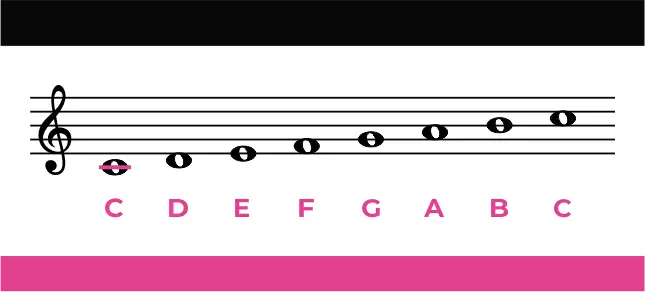
Take a look at the C Major Scale and how it moves from the lower C to the higher octave C. Note that when we start at middle C below the treble clef, we have to add an extra line to indicate its presence.
This goes for any notes that go above or below any staff.
Now, note that the C Major scale has eight notes , which match the white notes moving from C to C on the piano.
To practice these notes, you can play around with them on your piano or any other instrument you have handy to get a feel for how they move.
We don't want to dive into too much scale music theory in this article, as it's more about reading sheet music.
However, it is important to understand how we use certain musical symbols to change our scales and make our melody, harmony, and chordal changes more versatile.
Adding Sharps and Flats
The next step in music notation is adding sharps and flats, otherwise known as accidentals.
A sharp looks a lot like a little hashtag, while a flat looks like a fancy, lowercase B.
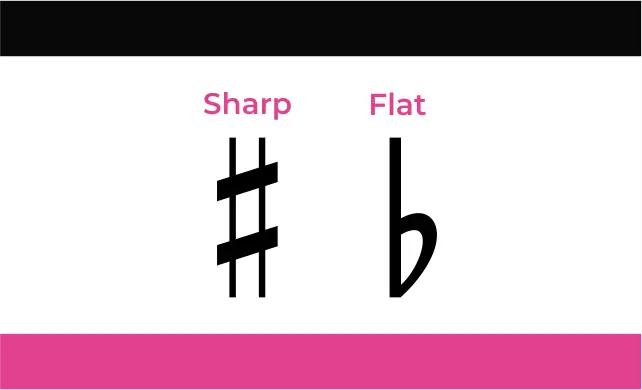
We place sharps and flats to the left side of a note's head to raise or lower that note by a half-step. When we want the note to be a half-step higher, we add a sharp. When we want the note to be a half-step lower, we add a flat.
The C Major scale doesn't have any sharps or flats in it. However, other major scales do, and when you learn more about different scales and keys, you'll learn which sharps and flats belong where.
It's best to think of sharps and flats as the black keys on a piano. However, there are a few instances where sharps and flats are white notes. For example, if you're in a key with a sharp on the B, that B# is actually the same as C . The reason we don't write it as C is due to some music notation rules, but that's a conversation for another time.
The important thing here is that there are exceptions to the rule.
Now, while we can add sharps or flats willy-nilly to make unique melodies or chords outside of the scale, they are usually dictated by what we call the key signature.
Why We Add Sharps And Flats
In western music, notes are either a whole tone or half-tone (semi-tone) apart. For example, if we look at the note middle C on a piano keyboard, we'll notice a black key between the white key C and the white key D. That black key is a semi-tone apart from both of these white keys.
The way in which we notate white and black keys or sharp and flat notes depends on a number of things.
Generally, if you're moving up or ascending in a scale, you'll use a sharp to represent a note. So, if we were moving from C to D in semi-tones and wanted to notate the black key in-between, we'd call it C#.
On the other hand, if we were moving down from D to C in semi-tones, we'd call it D♭.
With these kinds of conventions in place, it becomes much easier to read sheet music.
One important symbol to remember, which is right in-between these two, is the natural sign (♮).
A natural sign is there to cancel out any other accidentals that were written out previously. For example, let's say we notated a melody line moving from C to C# to D and back down to C. To let the player know not to go back to C# for the last note, we would put a natural sign on it.
Natural signs are also often used in key signatures with sharps and flats to let players know to take the sharp or flat off of those notes.
While it's not very common, you'll also sometimes see an "X" symbol when reading music. This "X" symbol means double sharp . So, for example, if a note C has an "x" in front of it, you would play the note C two semitones up on your piano keyboard, which would effectively or enharmonically make it the note D .
Diving Into Key Signatures
At this point, we've only focused on the key of C Major, which has eight notes on the white keys. The thing is, you can also start major scales on other notes.
However, if you start on note D with the intention of playing D major and simply play the white notes, you won't end up playing a major scale. Instead, you'll end up playing a "modal scale" of sorts.
If we start on D and want to play the D major scale, we'll have to add a sharp on F and a sharp on C.
Key signatures are found to the right of a clef. Here are all of the key signatures that represent major scales.
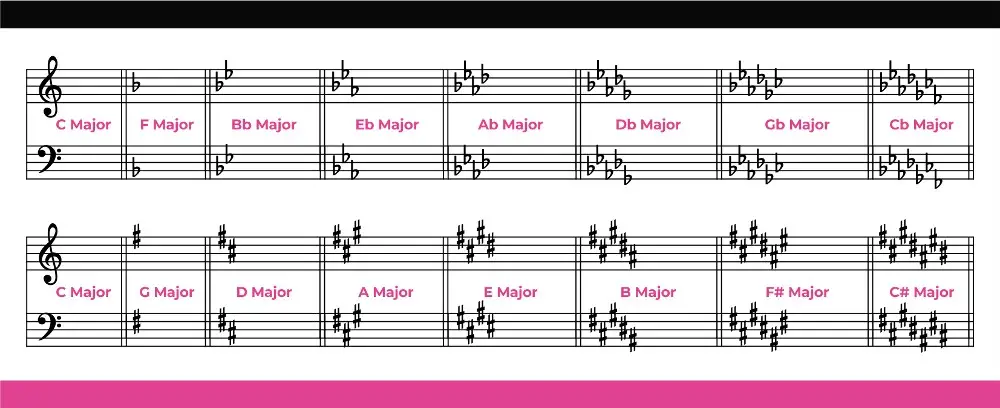
When you have a key signature, it tells you to play those sharps or flats throughout the piece. This eliminates the need to have sharps and flats on individual notes. As the player or singer, it's up to you to remember what key you're in and which sharps and flats you have to play in that key.
The thing to note with key signatures is that there is at least one key for each note in the western scale . In some cases, you'll find two keys that start on the same note.
For example, the key of A♭ is the same thing as the key of G#. The main difference is that the key signature has flats instead of sharps.
Here are the keys that use sharps:
- G Major - One sharp
- D Major - Two Sharps
- A Major - Three Sharps
- E Major - Four Sharps
- B Major - Five Sharps
- F# Major - Six Sharps
- C# Major - Seven Sharps
Here are the keys that use flats
- F Major - One Flat
- B♭Major - Two Flats
- E♭Major - Three Flats
- A♭ Major - Four Flats
- D♭ Major - Five Flats
- G♭ Major - Six Flats
- C♭Major - Seven Flats
It's also worth noting that each major key has a relative minor key that shares the same number of sharps and flats, though for the purpose of keeping this article simple, we won't get into that.
What's important to remember is that the music notes marked sharp or flat in the key signature should be played sharp or flat the entire time, unless the composer specifically marks it otherwise.
Adding Chord Symbols
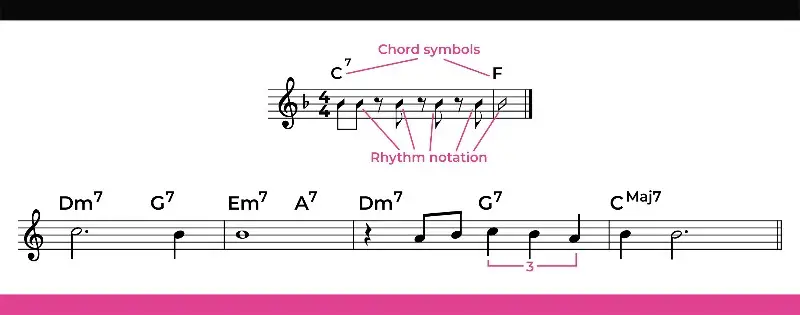
There are times in music when you'll find chord symbols , which are essentially shorthand notation to indicate the chords in each beat or bar of music. The beauty of chord symbols is that they take all of the guesswork out of playing, providing information on the harmony of the chord.
By looking at a chord symbol, you can tell whether it's a seventh, suspended, diminished, triad, etc.
When it comes to sixth, seventh, or higher extension chords, such as 9, 11, #11, 13, etc., those numbers will often sit to the right side of the note in smaller text.
Going A Bit Deeper With Dynamics
Now that we know a bit more about rhythm and melody, let's look at how we can use certain symbols to read sheet music and play with dynamics.
Rhythms and melody are at the foundation of music, though dynamics are where the soul lives.
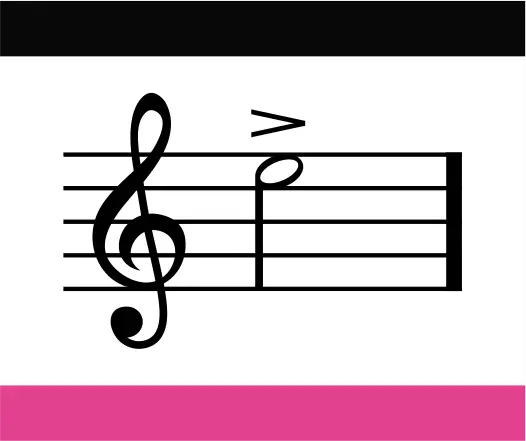
Let's look at the photo above. We can see that one of the notes in this phrase has an accent mark (>) underneath it. This accent mark tells us to give this particular note a bit more emphasis.
We can also use different letters to represent dynamics.
Dynamic Letters
When learning how to read sheet music, you'll often come across letters that symbolize dynamics. These letters tell us how soft or loud to play at any given time. Typically, a composer will write a letter to let the musician know their intention.
Some of the most common dynamic letters include F, M , and P .
- F stands for "forte" or "loud."
- P stands for "piano" or "soft."
- M stands for "mezzo" or "medium."
You can also put M before an F or P to tell the player "medium-loud" or "medium-soft."
Crescendo and Decrescendo
A few other crucial dynamic symbols to look out for when reading music are the crescendo and decrescendo sometimes referred to as the "diminuendo."
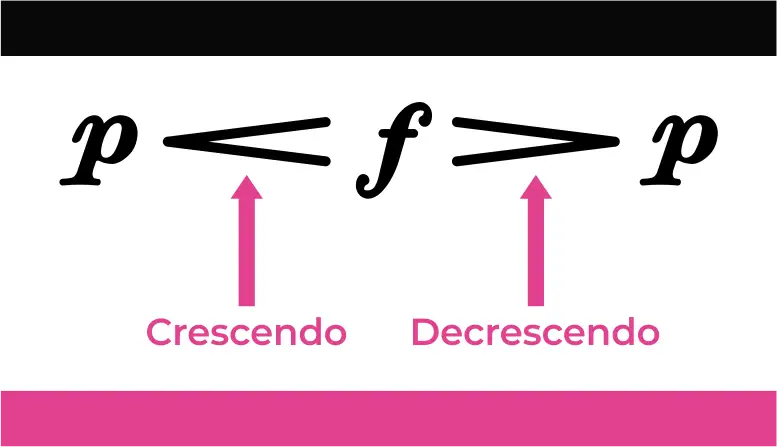
These stretched out ">" and"<" symbols represent gradual changes in volume over time.
When you see a crescendo symbol when reading music, it's telling you to get gradually louder .
When you see a decrescendo symbol when reading music, it's telling you to get gradually softer .
Tying this in with what we learned above, we'll sometimes see a forte symbol ( F ) with a decrescendo that moves into a piano symbol ( p ), which tells you to gradually move from loud to soft. You can also find this arrangement the other way around from soft to loud.
Special Markings
There are times when you'll find special markings or instructions on pieces of music. Don't let these scare you.
They are often there because the arranger or composer was not able to find the right musical symbol to express what they wanted out of the player. The true beauty of music is that we have conventions to rely on, allowing us to easily communicate with one another, yet the imagination has no limits.
If you want a saxophonist to play a certain note with a growl , you can write that in.
If you want a violinist to go through a certain passage whimsically , there's room for the composer to say that!
As you progress more and more in your abilities to read music, you'll come across these descriptors that are open for interpretation, offering a chance for you to breathe life into the music you're playing in your own special way.
Best Tools For Learning How To Read Sheet Music
All of the information above can act as a great foundation for learning how to read sheet music. However, what it really comes down to is whether or not you're able to utilize this knowledge in your practice.
The good thing is that there are tons of free piano sheet music resources online with scales, chords, melodies, and so much more, which you can use to expand your music theory knowledge and enhance your playing skills.
We recommend starting out by downloading some free sheet music. Start with some easy piano sheet music that you already know.
You can also check out the Music Notes app, which provides access to several unique tools and sheet music files for musicians of all experience levels. It's one of the most helpful apps for staying organized along your journey to read sheet music.
Final Thoughts - Learning How To Read Sheet Music With Ease
As with learning how to speak a different language, learning how to read sheet music requires tons of consistent practice. To truly get a grip on reading music, you need to be doing it as much as possible.
We hope that this article on how to read sheet music was helpful for you. Make sure to practice every day and seek helpful tools online. In no time, you'll be reading sheet music like a pro!


